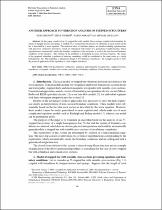JavaScript is disabled for your browser. Some features of this site may not work without it.
- ResearchSpace
- →
- Research Publications/Outputs
- →
- Journal Articles
- →
- View Item
| dc.contributor.author |
Fedotov, I

|
|
| dc.contributor.author |
Joubert, S

|
|
| dc.contributor.author |
Marais, J

|
|
| dc.contributor.author |
Shatalov, M

|
|
| dc.date.accessioned | 2007-07-04T12:11:53Z | |
| dc.date.available | 2007-07-04T12:11:53Z | |
| dc.date.issued | 2006 | |
| dc.identifier.citation | Fedotov, I, et al. 2006. Another approach to vibrational analysis of stepped structures. Electronic Transactions on Numerical Analysis, Vol. 24, pp 66-73 | en |
| dc.identifier.issn | 1068-9613 | |
| dc.identifier.uri | http://hdl.handle.net/10204/972 | |
| dc.description | Copyright: 2006 Kent State University | en |
| dc.description.abstract | In this paper a model of an N-stepped bar with variable Cross-sections coupled with foundation by means of lumped masses and springs is studied. It is assumed that the process of vibrations in each section of the bar is described by a wave equation. The analytical tools of vibration analysis are based on finding eigenfunctions with piecewise continuous derivatives, which are orthogonal with respect to a generalized weight function. These eigenfunctions automatically satisfy the boundary conditions at the end points as well as the non-classical boundary conditions at the junctions. The solution of the problems is formulated in terms of Green function. By means of the proposed algorithm a problem of arbitrary complexity could be considered in the same terms as a single homogeneous bar. This algorithm is efficient in design of low frequency transducers. An example is given to show the practical application of the algorithm to a two-stepped transducer. | en |
| dc.language.iso | en | en |
| dc.publisher | Kent State University | en |
| dc.subject | Stepped structures | en |
| dc.subject | Variable cross-sections | en |
| dc.subject | Eigenvalues | en |
| dc.subject | Non-classical boundary conditions | en |
| dc.subject | Green functions | en |
| dc.subject | Transducers | en |
| dc.title | Another approach to vibrational analysis of stepped structures | en |
| dc.type | Article | en |
| dc.identifier.apacitation | Fedotov, I., Joubert, S., Marais, J., & Shatalov, M. (2006). Another approach to vibrational analysis of stepped structures. http://hdl.handle.net/10204/972 | en_ZA |
| dc.identifier.chicagocitation | Fedotov, I, S Joubert, J Marais, and M Shatalov "Another approach to vibrational analysis of stepped structures." (2006) http://hdl.handle.net/10204/972 | en_ZA |
| dc.identifier.vancouvercitation | Fedotov I, Joubert S, Marais J, Shatalov M. Another approach to vibrational analysis of stepped structures. 2006; http://hdl.handle.net/10204/972. | en_ZA |
| dc.identifier.ris | TY - Article AU - Fedotov, I AU - Joubert, S AU - Marais, J AU - Shatalov, M AB - In this paper a model of an N-stepped bar with variable Cross-sections coupled with foundation by means of lumped masses and springs is studied. It is assumed that the process of vibrations in each section of the bar is described by a wave equation. The analytical tools of vibration analysis are based on finding eigenfunctions with piecewise continuous derivatives, which are orthogonal with respect to a generalized weight function. These eigenfunctions automatically satisfy the boundary conditions at the end points as well as the non-classical boundary conditions at the junctions. The solution of the problems is formulated in terms of Green function. By means of the proposed algorithm a problem of arbitrary complexity could be considered in the same terms as a single homogeneous bar. This algorithm is efficient in design of low frequency transducers. An example is given to show the practical application of the algorithm to a two-stepped transducer. DA - 2006 DB - ResearchSpace DP - CSIR KW - Stepped structures KW - Variable cross-sections KW - Eigenvalues KW - Non-classical boundary conditions KW - Green functions KW - Transducers LK - https://researchspace.csir.co.za PY - 2006 SM - 1068-9613 T1 - Another approach to vibrational analysis of stepped structures TI - Another approach to vibrational analysis of stepped structures UR - http://hdl.handle.net/10204/972 ER - | en_ZA |






